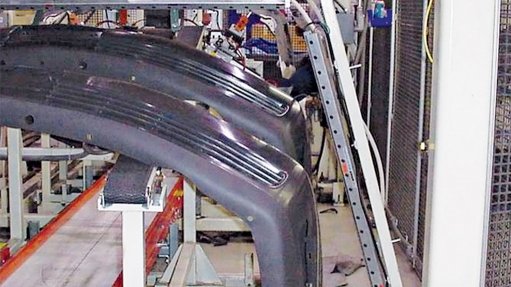
DUST-FREE ZONE A high velocity sheet of ionised air neutralises the static charge to release the dust
Using ionised compressed air to remove dust from vehicle bodies before painting can assist vehicle manufacturers with quality control in the local and export markets.
The automotive industry is faced with the problem of car bodies being primer-coated, followed by a sanding process before the bodies enter a paint booth for the colour scheme to be painted to the vehicle. During this process, priming dust is attracted to the car body by static electricity, creating imperfections that are captured and magnified in the painting process.
Pinetown-based instrumentation and electronics company Etest supplies the Super Ion Air Knife model 111024 24 to remove dust through a pneumatic system that blasts vehicle bodies.
The 61 cm air knife is installed upstream of the paint booth and, as the car bodies pass through the air knife, a high velocity sheet of ionised air neutralises the static charge to release the dust and blow it toward a collection system.
A nonturbulent airflow in this cleaning system has the ability to move most of the static- eliminating ions from the body surface, and the knife can be adjusted from a gentle breeze of air to a pounding blast, with instant on/off capability, which allows for air savings when the device is not in use.
Uniform airflow across the entire length of a vehicle body ensures that the entire body surface is neutralised and dust free.
Further, the air knife uses less compressed air than standard blow-off devices, producing about 69 dBA in noise pressure when applied to most applications.
The knife achieves this low-noise pressure through its use of compressed air that flows through an inlet and into the plenum chamber of the air knife. The flow is then directed to a precise, slotted orifice. As the primary airflow exits the thin slotted nozzle, it follows a flat surface that directs the airflow in a perfectly straight line, creating a uniform sheet of air across the entire length of the air knife.
Air velocity loss is reduced and force is increased, as ambient air is drawn into the primary airstream at a ratio of 40:1. The result is a well-defined sheet of laminar airflow with hard-hitting force and minimal wind shear.
The laminar sheet of air sweeps surfaces clean of static, particulate, dust and dirt.
Production speeds, product quality and surface cleanliness can improve dramatically as it eliminates static from a distance of up to 6.1 m away.
The air knife is compact, rugged and easy to install, with no moving parts and, therefore, maintenance procedures are minimal.